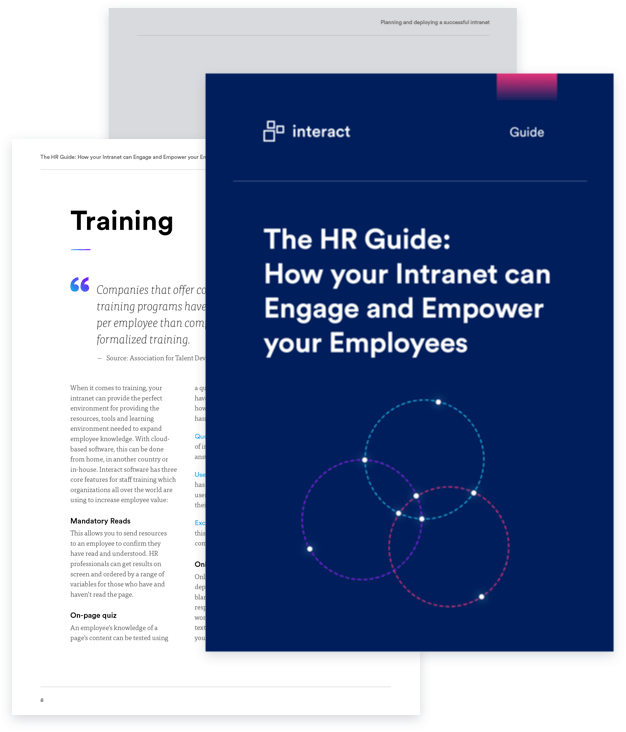Engaged and empowered employees who are invested in their organization and its mission are perhaps the most powerful asset any business can have. But how can an intranet support HR leaders in realizing that vision?
Intranets and social technology are often regarded as the responsibility of internal communications, marketing, or even the IT department. The truth is, the HR department holds the key to success for a company intranet – and also stands to be one of the biggest beneficiaries.
Social technology not only facilitates knowledge sharing and connects individuals: it plays a central role in building a successful, inclusive, and engaged culture. It can support well-being, develop and communicate the employer brand, and directly shape the employee experience. It positively impacts on key HR objectives such as workplace satisfaction, retention, and productivity.
Empower and engage your employees – An intranet for HR
Whether you’re looking to understand the value an intranet could bring to your HR department, or you’re trying to secure HR buy-in for your intranet project, understanding (and communicating) these 6 key benefits will change the way you see the potential of intranet software from the HR perspective.
1. Cut down on administration
Save valuable HR time and resource with the support of digital tools, workflows and processes
Driving efficiency and enabling employees to do ‘more with less’ is a top-level objective for many organizations looking to reduce costs and maximize returns.
By investing in self-serving processes, HR leaders can not only improve the employee experience but also dramatically reduce time spent on administrative tasks: giving HR representatives more time to focus on proactive and business-critical objectives that will support your organization and its employees.
A few examples where self-service can be implemented on an intranet include:
- New starter processes
- Payroll or salary Q&As
- 401K or health insurance information
- Business policies, procedures, or essential documentation
- Performance reviews
Let’s consider the business value of centralized hosting 401K, health insurance, or policy and procedural information.
Organizations have huge knowledge assets. Traditionally, these may be dispersed across a multitude of internal servers, individual desktops or files, cloud hosting platforms, or even in paper-based filing systems. In some organizations, there’s simply just that ‘one person’ who is the go-to for all the answers.
This is not only time-consuming when it comes to searching and finding information, but an extremely high-risk approach to information management. You may face multiple versions of documents, with employees not accessing the most up-to-date documentation. They may be costing your business by failing to use a preferred supplier, perhaps – or more fatefully, failing to comply with mandatory procedures, leaving your organization vulnerable to errors in practice or even legal action due to non-compliance.
“While the average cost of compliance for organizations [in our study] is $3.5 million, the cost of non-compliance is much greater. The average cost for organizations that experience noncompliance related problems is nearly $9.4 million.” (Source: ‘The True Cost of Compliance’, Ponemon Institute LLC)
Centralizing this information on a company intranet ensures a single version of truth, while the searchable nature of an intranet delivers productivity and efficiency gains for employees. For HR representatives, there’s also hugely valuable personal time saving.
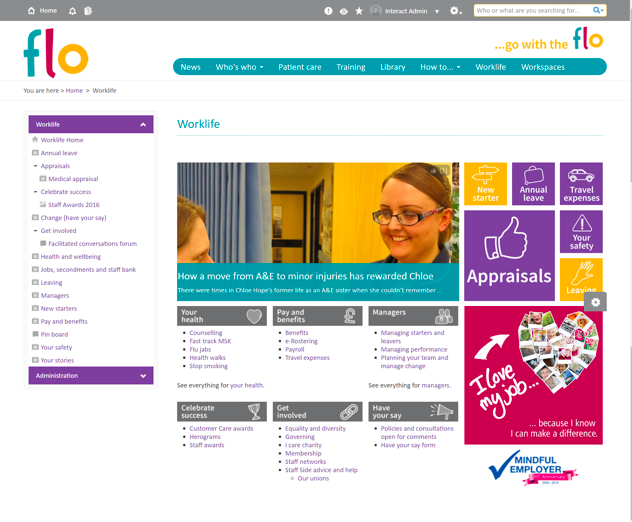
(UK healthcare provider, Kent Community Health NHS Foundation Trust, use their intranet ‘Flo’ to centralize all vital business and HR processes. In the ‘Worklife’ section, employees can access benefit and payroll information, read vital company policies, submit travel expenses, complete appraisals and much more.)
For example, let’s assume that a personnel manager is asked a common question every day regarding a policy, such as the company 401K. If it takes an average of 30 minutes to answer these inquiries, and housing policy and Q&As on an intranet can reduce these by 50%, the personnel manager could save 75 minutes per week, or 9 days a year of time. Even the small marginal gains soon add up.
Royal Mail Property & Facilities Management saved GBP2 million per year
A considerable element of Royal Mail Property and Facilities Management’s success when saving over GBP2 million per year was to drive the most time consuming and widely used processes on to their intranet. They used Workflow and Forms to manage their review process, with all 4,500 employees conducting their preparation on their intranet. While the performance review itself is face-to-face, quarterly follow ups and any training needs are processed on their intranet.
For many companies, there is a two month drain on HR admin processing performance reviews, by automating it this disappears. Forms can’t be submitted without all relevant information, reminders are automatic and reporting is a simple.
2. Support employees with a centralized digital workplace
Give employees the tools and information they need to perform their roles effectively and efficiently
The most powerful and successful intranets don’t set out to replace HR or business systems. These are typically specialized, already embedded into a business, and have a critical role to play – an intranet claiming to be a jack of all trades is likely to be a master of none.
However, as technology continues to play a central role in business strategy, intranets can be a vital addition to the technology stack that will complement and support existing systems and processes. Using integration functionality and user-centric tools, intranets can serve as:
- Company information platforms, to keep both employee and employer informed. For example, they offer an efficient and simple way for employees to submit and maintain vital data such as contact or payroll details, and for HR to keep employees updated with relevant business information
- A central point for transactional processes, such as finding colleagues, information, or submitting internal forms
- Enterprise portals, connecting with all other business systems to provide a single, centralized access point for employees. Configuring your intranet as an identity provider with outbound Single Sign-On (SSO) can also simplify application access, improving the digital workplace experience for employees by giving them fewer passwords and logins to remember!
- Searchable document or content management systems, with all essential documents and information easily accessed from a centralized location
- Communication and collaboration platforms, offering an intuitive and user-orientated way for employees to work effectively together
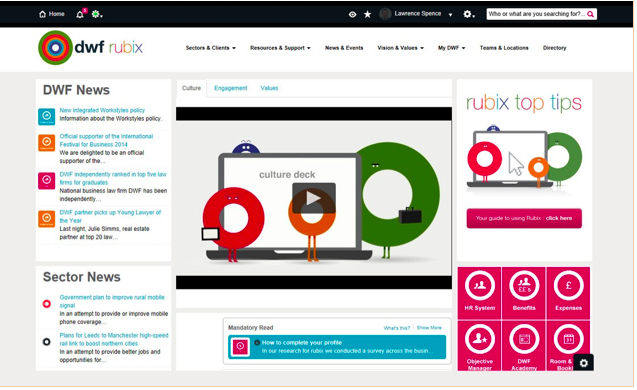
(Law firm DWF uses icons on the homepage of its intranet, Rubix, to direct employees to perform transactional processes, such as booking rooms and resources, as well as connecting them to third-party tools such as the HR system in order to complete specialized tasks. Find out more about their intranet journey here.)
Tools on your intranet such as the People Directory are used daily, and as a result employees tend to be more vigilant about keeping their details and information up to date. Content is dynamic and frequently updated, keeping employees coming back – unlike purely process-driven business platforms such as your HR systems, which employees may only log into periodically when it serves a specific purpose.
When designed with HR objectives in mind and deployed strategically, a successful intranet is a powerful facilitator of the digital workplace.
Empower and engage your employees – An intranet for HR
3. Build your employer brand and support recruitment initiatives
Establishing an engaged, unified culture in today’s globalized business marketplace is a growing challenge and priority for the HR profession. It not only plays a central role in shaping a positive employee experience, but employer branding is now consistently cited as a top consideration for Millennial and Gen Z generations seeking opportunities.
“Millennials don’t just work for a paycheck – they want a purpose,” Management Consultants Gallup state in their report, ‘How Millennials want to work and live’.
“For Millennials, work must have meaning. They want to work for organizations with a mission and purpose.”
However, when your staff are demographically and geographically diverse, often silo-ed within their own departments or specialties and not engaging face-to-face with their peers, how do you create a common culture ? How do you empower employees to become advocates for your business, and communicate what makes your business a great place to work?
An intranet can prove a valuable tool here also:
- Use it to communicate and embed your company values, vision and mission: just four in ten employees know what they company stands for and what makes them different from competitors (Gallup). However, mission-driven companies have 30% higher levels of innovation, 40% higher levels of retention and tend to be first or second in their market segment. A centralized intranet can be used to publish and push your company mission and values, ensuring they remain ‘front of mind’ and translate into the day-to-day jobs of employees. Display them on staff homepages, use them as a #hashtag in communications or to underpin your recognition initiatives. Celebrate them. All these hacks keep your business vision visible – and help secure employee buy-in.
- Communicate who you are and what you do: Break down disconnect between different offices or functions by communicating about your business: the projects, the challenges, the events, the achievements. With communications-focused intranet software, content can be updated regularly, allowing you to broadcast new initiatives, forthcoming events, or to publicize or recognize success, without the requirement for IT involvement. The result is a virtual culture, in which employees who may never meet or speak in person will have acute awareness of where their organization is headed, who has contributed to that success, the governing values that direct its actions and their own place within the bigger picture.
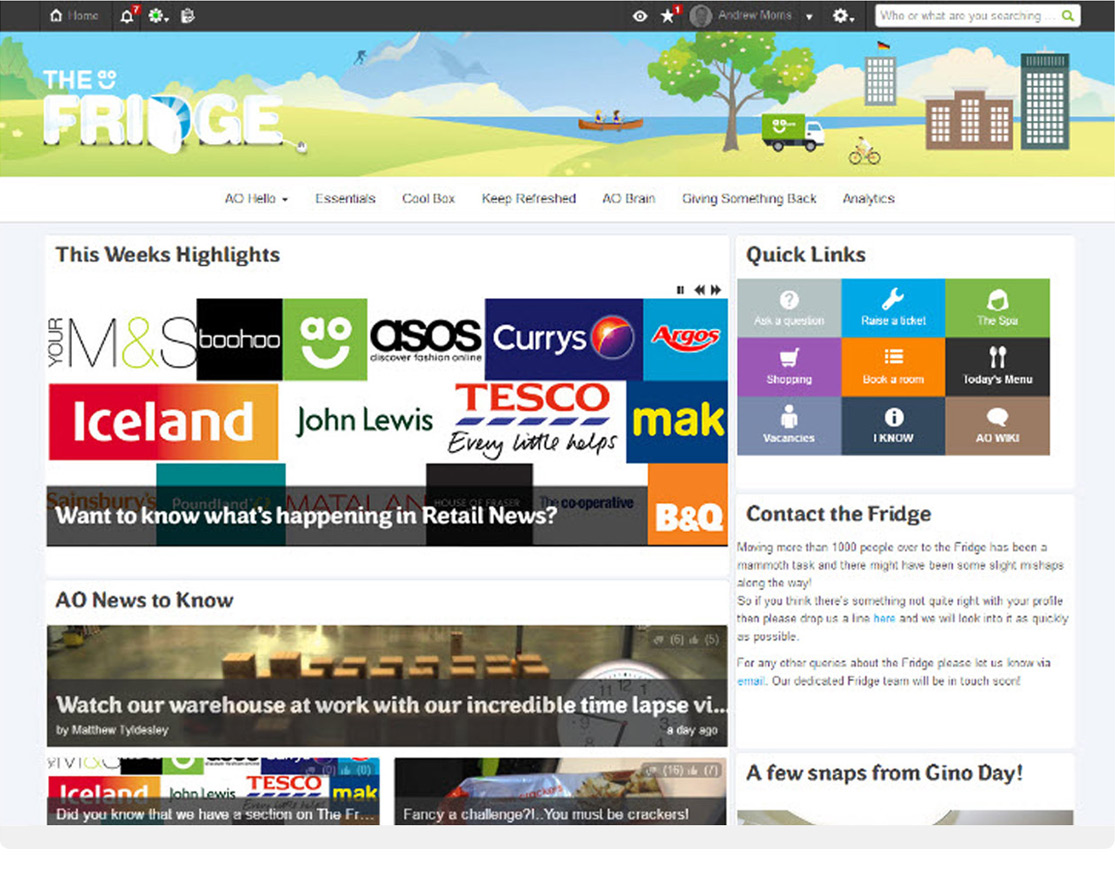 (On their intranet, ‘The Fridge’, AO.com displays highlights and news prominently on the homepage, alongside photos and their own ‘A day in the life of…’ initiative. The result is a highly engaging and dynamic intranet site that engrosses users in the culture and ethos of the organization, ensuring every employee feels informed, engaged, and part of the bigger picture.)
(On their intranet, ‘The Fridge’, AO.com displays highlights and news prominently on the homepage, alongside photos and their own ‘A day in the life of…’ initiative. The result is a highly engaging and dynamic intranet site that engrosses users in the culture and ethos of the organization, ensuring every employee feels informed, engaged, and part of the bigger picture.)
- Build an internal brand your employees identify with and love: while millions of dollars is spent annually on building and promoting external company brands, few organizations invest the same effort or resource into internal branding efforts. However, a strong internal brand connects employees to the company vision, mission, culture and identity. This in turn drives their engagement, workplace satisfaction and productivity. Your intranet can serve as a platform for building, communicating, and embedding your internal brand. Align it with your external brand, give it a name, an identity, a voice. Make it recognizable and relatable. When employees have a positive experience, they are also far more likely to advocate for your business externally – an essential strategy in an age of Glassdoor and employer review sites.
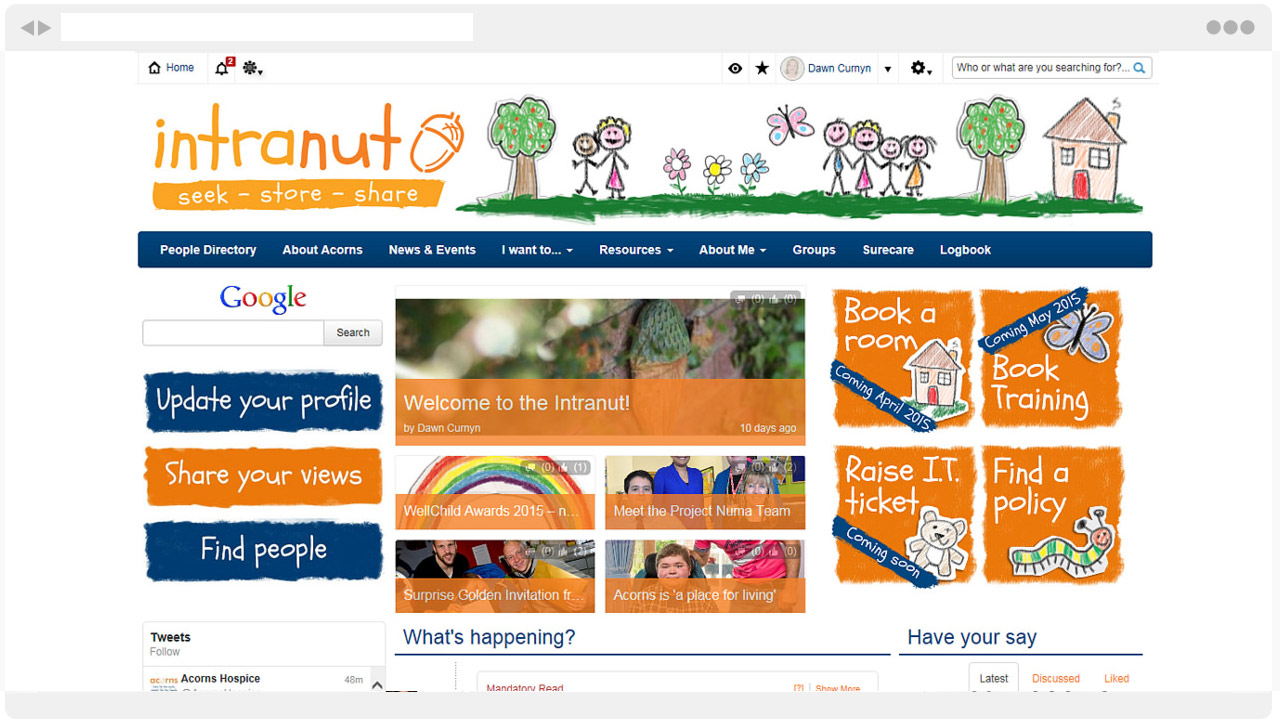
(Children’s Hospice, Acorns, created a strong identity on their intranet, ‘Intranut’ that would embed the culture and mission of the organization. The branding aligns with their external brand in terms of colors and look/feel, but is focused on those they provide support and care for – children – ensuring that users feel connected to the purpose and ideals of the nonprofit.)
The process of using employees to create and communicate a great online brand is something explored by guest blogger and freelance web specialist Patrick Foster, writing for the Interact blog here: How to design a great online brand – starting with your employees.
- Establish an employee referral program: Utilize your intranet to publicize current vacancies and run an employee referral program. Your employees are best placed to recommend individuals who identify with your company culture and will be retained by your organization, and research suggests employee referrals boost the odds of a successful hire by as much as 6.6%.
4. Manage and monitor employee development
Motivate, recognize and performance manage your employees
One of the key trends identified for HR strategy in the coming 24 months is the desire of employees for agile, continuous development and feedback. “Annual reviews”, research experts Gallup state, “no longer work.”
Employee development is not only important to the individual concerned; it is also the foundation of many organization’s retention and talent management plans, making it a top-ranking priority for HR managers everywhere. But how can an intranet support that process?
There are a few different features and capabilities that intranets can deliver value in this area. In point 1, we discussed the value of an intranet to support administrative processes. Using the intranet to centralize information relating to performance management – such as progression charts, KPIs, performance management forms or feedback surveys – streamlines and simplifies the admin side of managing employee development. Workflows can be digitalized, such as filling in and submitting appraisal forms, sending out reminders or booking reviews.
An intranet can also give greater visibility of employee efforts, contributions and opinions. Team areas, discussion forums and pulse surveys can provide real-time insights into company and employee well-being, highlighting areas requiring attention and response.
In a fast-paced digital age in which individuals are accustomed to communicating in real time, employees increasingly expect conversations with managers and their organization to be instantaneous. Employees who feel their efforts are recognized and rewarded also deliver business benefits spanning increased productivity, higher retention rates, improved engagement, better levels of customer service and bottom line profitability.
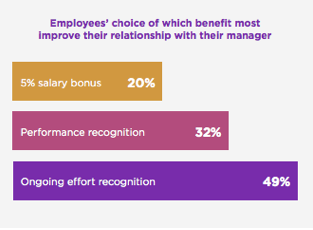
(Source: The Effect of Performance Recognition on Employee Engagement, Cicero)
An intranet with an embedded incentive or reward system offers an agile, two-way platform for real time feedback and communication, as well as opportunities for continual recognition. Whether you want to empower employees to celebrate one another with a peer-to-peer program or simply make the manager-to-employee reward program instantaneous, your intranet is the ideal solution.
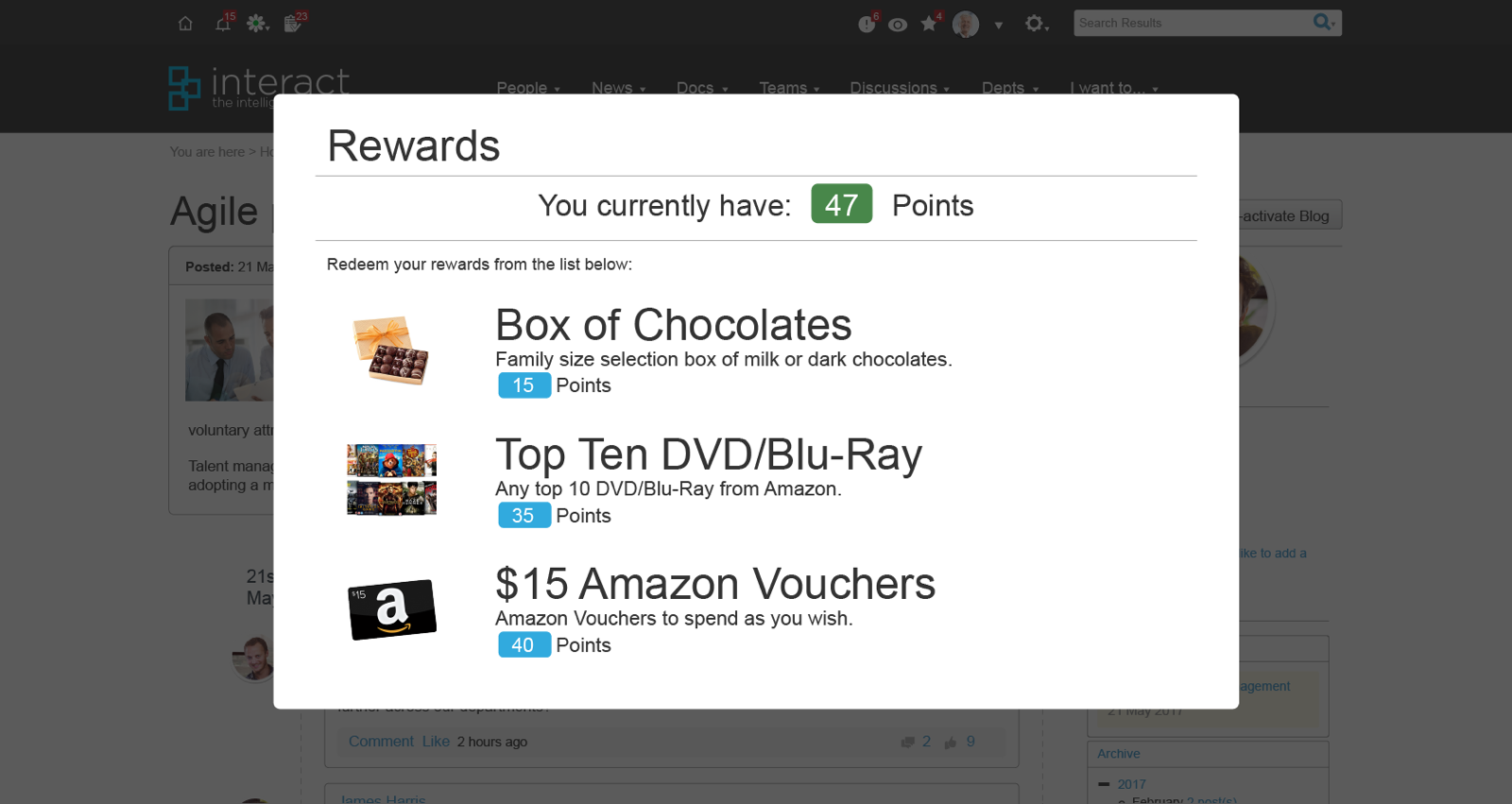
(Interact offers a build-in rewards feature, that uses gamification to empower organizations to give recognition. Discover more about how an intranet can be used as a performance management system with our free eBook, available here.)
In addition, many organizations have successfully utilized their intranets as a tool for managing training and development, whether by hosting training programs, videos, quizzes or collateral, or creating a training center from which users can navigate to essential tools and platforms to upskill and progress.
How does Dollar Finance encourage discretionary training?
Financial services provider Dollar Finance secured recognition as ‘Best Social Intranet’ with their intranet, Daily Dollar. One area in which they’ve excelled is use of their intranet to support their excellent staff training department. In this free webinar they give a live tour of their intranet, sharing their approach to making training accessible and valuable for every employee.
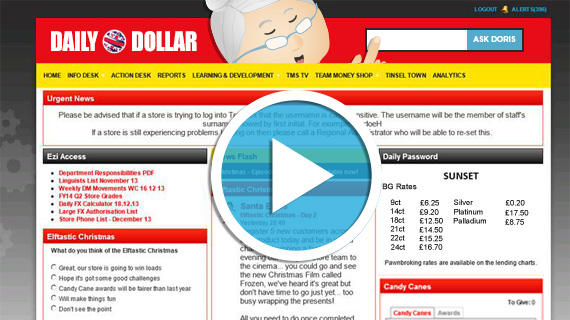
5. Onboard and train employees
Studies show that the time it takes for new hires to become productive can be as great as 12 months, presenting a considerable loss to your organization. Furthermore, employee turnover is typically highest during the initial period of employment: a study by BambooHR puts this figure at 16-17% of employees leaving between the first week and the third month of starting their new job.
Despite this, onboarding processes do little to make those first valuable few weeks a positive experience. How many times on first days are new employees paraded around an office, introduced to a mass of people they don’t have a hope of remembering the name of? Have you ever spent your first day wading through policies and procedures which again you’ll never retain?
Empower and engage your employees – An intranet for HR
This doesn’t have to be the case. A comprehensive onboarding process and the ability to immerse new employees in the company culture can have significant impact on reducing both the time it takes to become productive and employee turnover. Centralizing this around your company intranet can prove highly effective and efficient, maximizing the experience for your employees and reducing the burden on HR resource.
Help new starters find their feet and the information they need with a personalized onboarding experience. Tailored new starter pages that can be accessed even before day one give new hires access to relevant tools and information they need to get orientated. Use content areas and discussion forums to answer commonly asked questions, and relieve some of that first-day admin by getting new hires to fill in vital paperwork ahead of their first day.
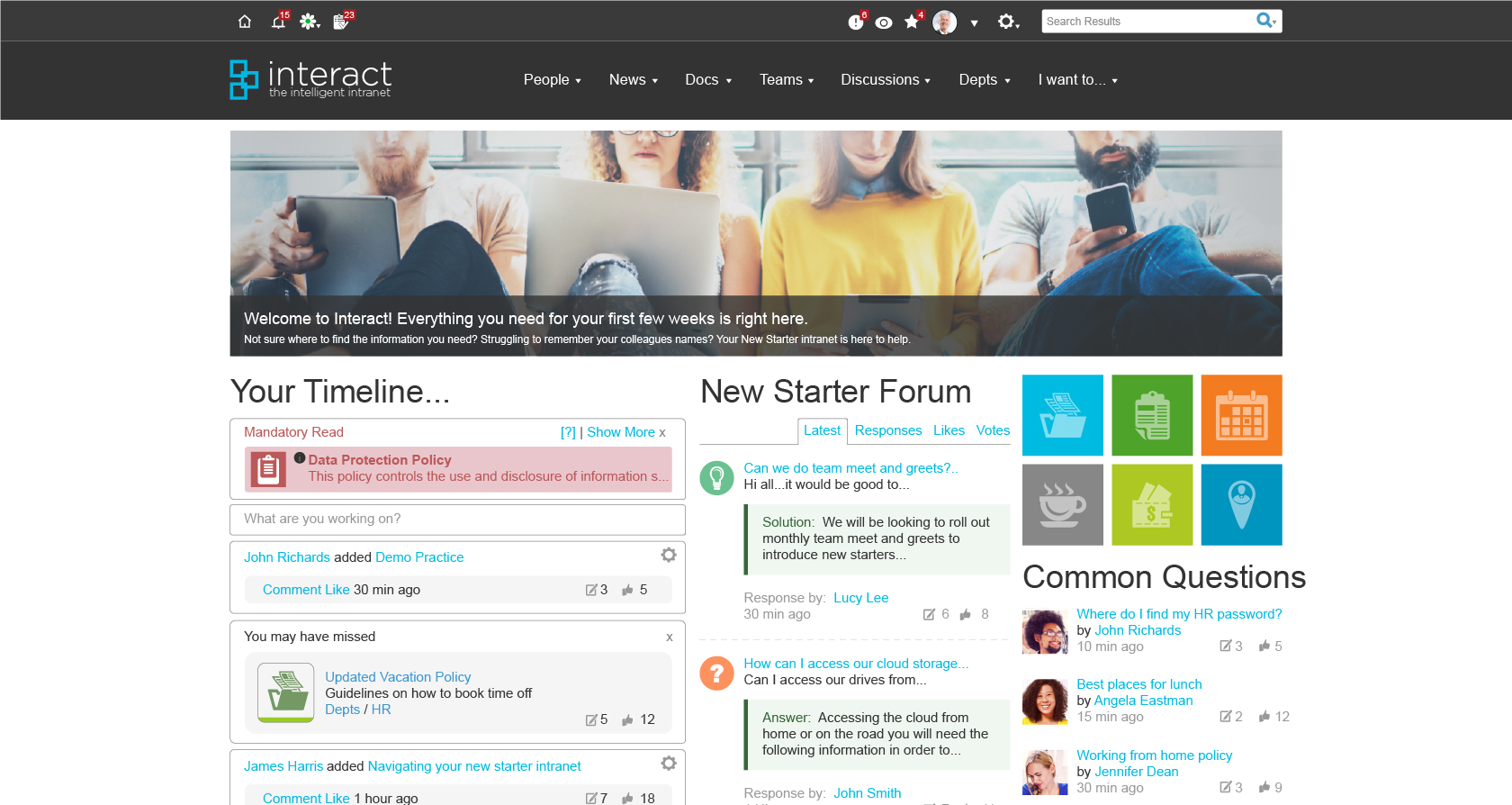
With access to an organization chart and the People Directory, new starters can also begin to learn about their colleagues and their roles, while access to company information such as your mission, values or recent achievements can get them quickly immersed into the culture.
How Do Epilepsy Action approach on-boarding?
The UK’s leading epilepsy charity, Epilepsy Action, was seeking innovative ways to improve its new starter experience. Seeing this as the best time for the business to learn from individuals coming in with ‘fresh perspective’, they designed a unique bottom-up feedback process via their intranet.
As new starters complete their induction on the intranet, they undertake a questionnaire for the individual to highlight anything they felt was missing, or perhaps had in their old company which wasn’t available. New starters can contribute from day one, while the interactive process helps engage new employees, rather than simply giving them handbooks and materials to read through.
6. Support remote workers, telecommuters, and regional offices or staff
Technology has given many organizations more opportunity and flexibility than ever before. The result is a growing trend towards dispersed workforces, with employees now able to perform their roles regardless of their location.

Telecommuting, remote working and globalization are all on the rise; however, this demographic of the workforce also comes with its own set of unique challenges. For HR representatives, the largest concerns are:
- The impact on organizational culture and individual well-being
- Accountability and visibility
- Security – both physical, and digital
- Maintaining boundaries between work life and home life
- Timezone and communication difficulties
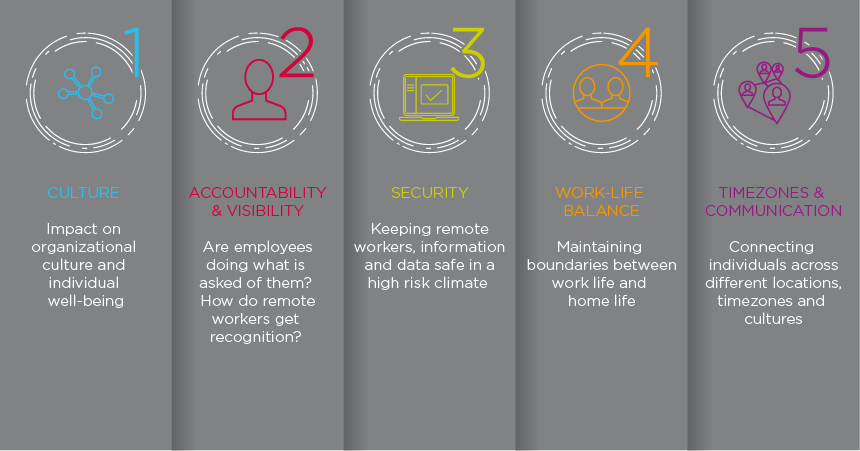
Connecting and engaging a dispersed workforce demands a flexible, agile infrastructure. To remain productive, employers must provide employees with the tools, information and support they require to do their jobs well and thrive.
A cloud hosted intranet with a solid document or content management system and/or integration with your cloud storage ensures staff have access to all your documents, policies, forms, and information, no matter where they’re based. They can also access vital business systems and perform critical tasks at any time, from anywhere.
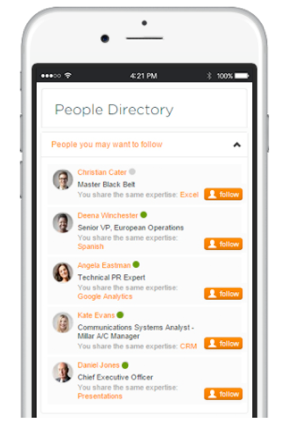
A social intranet with a People Directory at its core breaks down siloes within your business. Rich profiles enable users to find colleagues by job title, department, interests or expertise and connect or communicate instantly with social tools.
Team areas also bring together communities within your organization. Whether project, social, hobby or team related, these interactive collaborative spaces on your intranet will help your employees break out of the email inbox, and feel part of their organization.
Intranet systems now also prioritize mobile experiences, catering for on-the-road workers with intranet apps or mobile versions. HR managers can use push notifications to distribute essential updates and information, ensuring these aren’t missed.
We explore the challenges facing remote workers and how HR can address these in our blog. Interact remote worker Linda also writes from personal experience about how an intranet has supported and enriched her experience working outside of the office.
Intranets: A HR tool for success
In the six topics we’ve explored above, you’ll have gained an understanding of the diverse range of ways in which an intranet can support and even drive tangible benefits for HR managers and departments.
What has been traditionally considered an internal communications tool has evolved into a powerful enterprise-wide platform, offering features and functionality that can help every employee perform their roles. Given the potential gains in terms of employee engagement, retention, productivity, compliance and more, that’s something every HR professional should be adding to their strategy.
